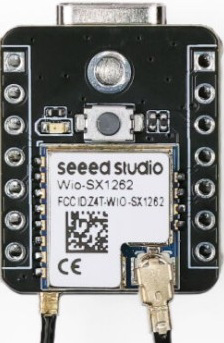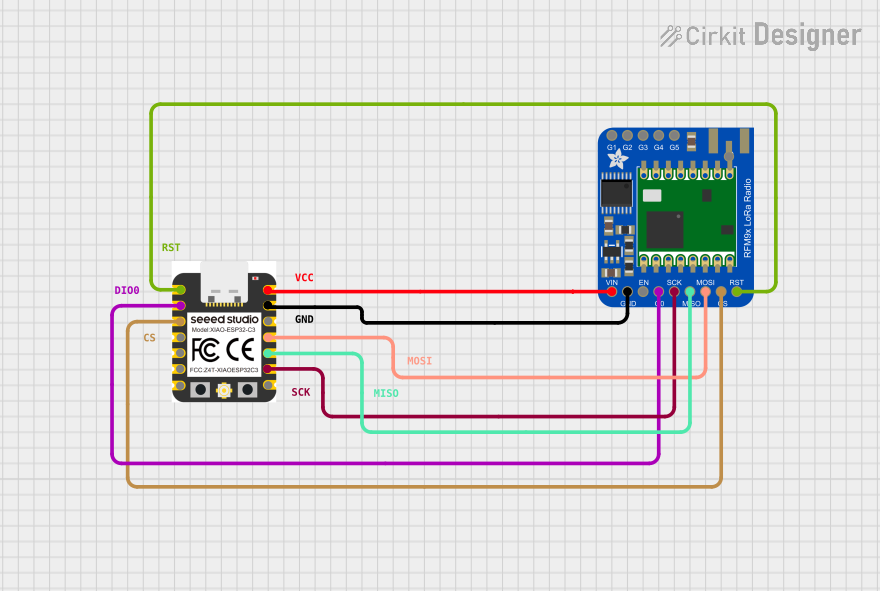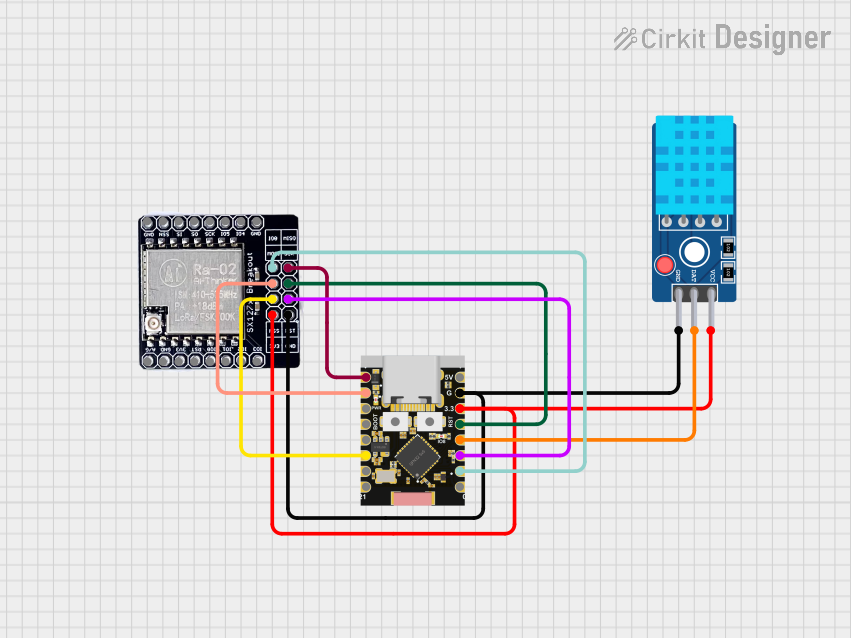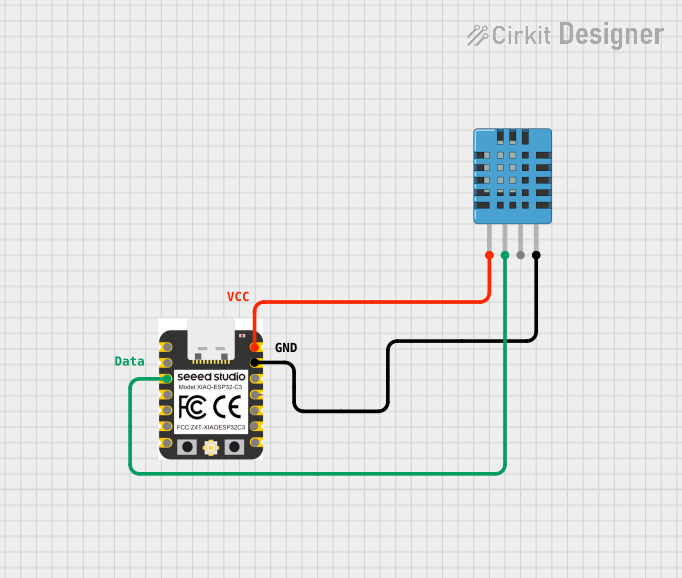
How to Use XIAO ESP32S3 & Wio-SX1262 Meshtastic/LoRa Kit: Examples, Pinouts, and Specs

 Design with XIAO ESP32S3 & Wio-SX1262 Meshtastic/LoRa Kit in Cirkit Designer
Design with XIAO ESP32S3 & Wio-SX1262 Meshtastic/LoRa Kit in Cirkit DesignerIntroduction
The XIAO ESP32S3 & Wio-SX1262 Kit by Seeed Studios is a compact and versatile development kit designed for IoT applications requiring long-range wireless communication. It combines the powerful XIAO ESP32S3 microcontroller, which features dual-core processing and Wi-Fi/Bluetooth connectivity, with the Wio-SX1262 LoRa module, enabling low-power, long-range communication using the LoRaWAN protocol. This kit is ideal for building mesh networks, remote sensing systems, and IoT devices that require reliable communication over extended distances.
Explore Projects Built with XIAO ESP32S3 & Wio-SX1262 Meshtastic/LoRa Kit

 Open Project in Cirkit Designer
Open Project in Cirkit Designer
 Open Project in Cirkit Designer
Open Project in Cirkit Designer
 Open Project in Cirkit Designer
Open Project in Cirkit Designer
 Open Project in Cirkit Designer
Open Project in Cirkit DesignerExplore Projects Built with XIAO ESP32S3 & Wio-SX1262 Meshtastic/LoRa Kit

 Open Project in Cirkit Designer
Open Project in Cirkit Designer
 Open Project in Cirkit Designer
Open Project in Cirkit Designer
 Open Project in Cirkit Designer
Open Project in Cirkit Designer
 Open Project in Cirkit Designer
Open Project in Cirkit DesignerCommon Applications and Use Cases
- IoT Mesh Networking: Create robust, low-power mesh networks for smart cities or industrial IoT.
- Environmental Monitoring: Deploy sensors for temperature, humidity, or air quality in remote areas.
- Asset Tracking: Enable GPS-free tracking of assets using LoRa communication.
- Smart Agriculture: Monitor soil moisture, weather conditions, and crop health over large areas.
- Home Automation: Build long-range, low-power smart home devices.
Technical Specifications
Key Technical Details
| Feature | Specification |
|---|---|
| Microcontroller | XIAO ESP32S3 (ESP32-S3R8) |
| Processor | Dual-core Xtensa LX7, up to 240 MHz |
| Flash Memory | 8 MB |
| SRAM | 512 KB |
| Wireless Connectivity | Wi-Fi 802.11 b/g/n, Bluetooth 5.0 (LE) |
| LoRa Module | Wio-SX1262 (Semtech SX1262) |
| LoRa Frequency Bands | 868 MHz (EU), 915 MHz (US), 433 MHz (Asia) |
| LoRa Range | Up to 10 km (line of sight, depending on environment and antenna) |
| Operating Voltage | 3.3V |
| Power Supply | USB-C (5V input) |
| GPIO Pins | 11 (including ADC, PWM, I2C, SPI, UART) |
| Dimensions | 21 x 17.5 mm (XIAO ESP32S3), 40 x 40 mm (Wio-SX1262 module) |
| Operating Temperature | -40°C to 85°C |
Pin Configuration and Descriptions
XIAO ESP32S3 Pinout
| Pin Name | Type | Description |
|---|---|---|
| 3V3 | Power | 3.3V power output |
| GND | Ground | Ground connection |
| D0 | GPIO/ADC | General-purpose I/O, ADC input |
| D1 | GPIO/PWM | General-purpose I/O, PWM output |
| D2 | GPIO/I2C SDA | General-purpose I/O, I2C data line |
| D3 | GPIO/I2C SCL | General-purpose I/O, I2C clock line |
| RX | UART RX | UART receive pin |
| TX | UART TX | UART transmit pin |
| RST | Reset | Reset pin |
| SWDIO | Debug | Serial Wire Debug I/O |
| SWCLK | Debug | Serial Wire Debug clock |
Wio-SX1262 LoRa Module Pinout
| Pin Name | Type | Description |
|---|---|---|
| VCC | Power | 3.3V power input |
| GND | Ground | Ground connection |
| MISO | SPI | SPI Master In Slave Out |
| MOSI | SPI | SPI Master Out Slave In |
| SCK | SPI | SPI clock |
| NSS | SPI | SPI chip select |
| DIO1 | GPIO | General-purpose I/O, used for LoRa interrupts |
| RST | Reset | Reset pin |
| ANT | RF | Antenna connection |
Usage Instructions
How to Use the Component in a Circuit
- Power the Kit: Connect the XIAO ESP32S3 to a 5V USB-C power source. Ensure the Wio-SX1262 module is securely connected to the XIAO board.
- Connect Peripherals: Use the GPIO pins on the XIAO ESP32S3 for sensors, actuators, or other peripherals. For LoRa communication, ensure the antenna is properly attached to the Wio-SX1262 module.
- Program the Microcontroller: Use the Arduino IDE or PlatformIO to upload code to the XIAO ESP32S3. Install the necessary board definitions and libraries (e.g.,
LoRalibrary for LoRa communication). - Establish LoRa Communication: Configure the Wio-SX1262 module for the desired frequency band and communication parameters (e.g., spreading factor, bandwidth).
- Deploy the Device: Place the device in the desired location, ensuring a clear line of sight for optimal LoRa range.
Important Considerations and Best Practices
- Antenna Placement: Ensure the LoRa antenna is securely connected and positioned away from metal objects to avoid signal interference.
- Power Supply: Use a stable 5V power source to avoid voltage fluctuations that could affect performance.
- Frequency Compliance: Verify that the selected LoRa frequency band complies with local regulations.
- Heat Management: Operate the kit within the specified temperature range to prevent overheating.
Example Code for Arduino UNO
Below is an example of how to send a simple LoRa message using the XIAO ESP32S3 and Wio-SX1262 module:
#include <SPI.h>
#include <LoRa.h>
// Define LoRa module pins
#define SCK 5 // SPI clock
#define MISO 19 // SPI MISO
#define MOSI 27 // SPI MOSI
#define NSS 18 // LoRa chip select
#define RST 14 // LoRa reset
#define DIO0 26 // LoRa interrupt
void setup() {
Serial.begin(9600); // Initialize serial communication
while (!Serial);
// Initialize LoRa module
LoRa.setPins(NSS, RST, DIO0);
if (!LoRa.begin(915E6)) { // Set frequency to 915 MHz
Serial.println("Starting LoRa failed!");
while (1);
}
Serial.println("LoRa initialized successfully!");
}
void loop() {
Serial.println("Sending message...");
LoRa.beginPacket(); // Start LoRa packet
LoRa.print("Hello, LoRa!"); // Add message to packet
LoRa.endPacket(); // Send packet
delay(5000); // Wait 5 seconds before sending again
}
Troubleshooting and FAQs
Common Issues and Solutions
LoRa Module Not Initializing
- Cause: Incorrect wiring or frequency mismatch.
- Solution: Double-check the SPI connections and ensure the frequency matches the local regulations.
Poor Signal Range
- Cause: Antenna placement or environmental interference.
- Solution: Reposition the antenna for a clear line of sight and avoid obstacles.
Microcontroller Not Recognized by PC
- Cause: Missing drivers or faulty USB cable.
- Solution: Install the required USB drivers for the XIAO ESP32S3 and try a different cable.
High Power Consumption
- Cause: Continuous LoRa transmission or Wi-Fi usage.
- Solution: Optimize the code to use low-power modes and reduce transmission frequency.
FAQs
Q: Can I use this kit with other microcontrollers?
- A: Yes, the Wio-SX1262 module can be interfaced with other microcontrollers via SPI.
Q: What is the maximum data rate for LoRa communication?
- A: The maximum data rate depends on the spreading factor and bandwidth but typically ranges from 0.3 kbps to 50 kbps.
Q: Is the kit compatible with the Arduino IDE?
- A: Yes, the XIAO ESP32S3 is fully compatible with the Arduino IDE.
Q: Can I use this kit for GPS-free tracking?
- A: Yes, the LoRa module supports mesh networking, which can be used for GPS-free asset tracking.